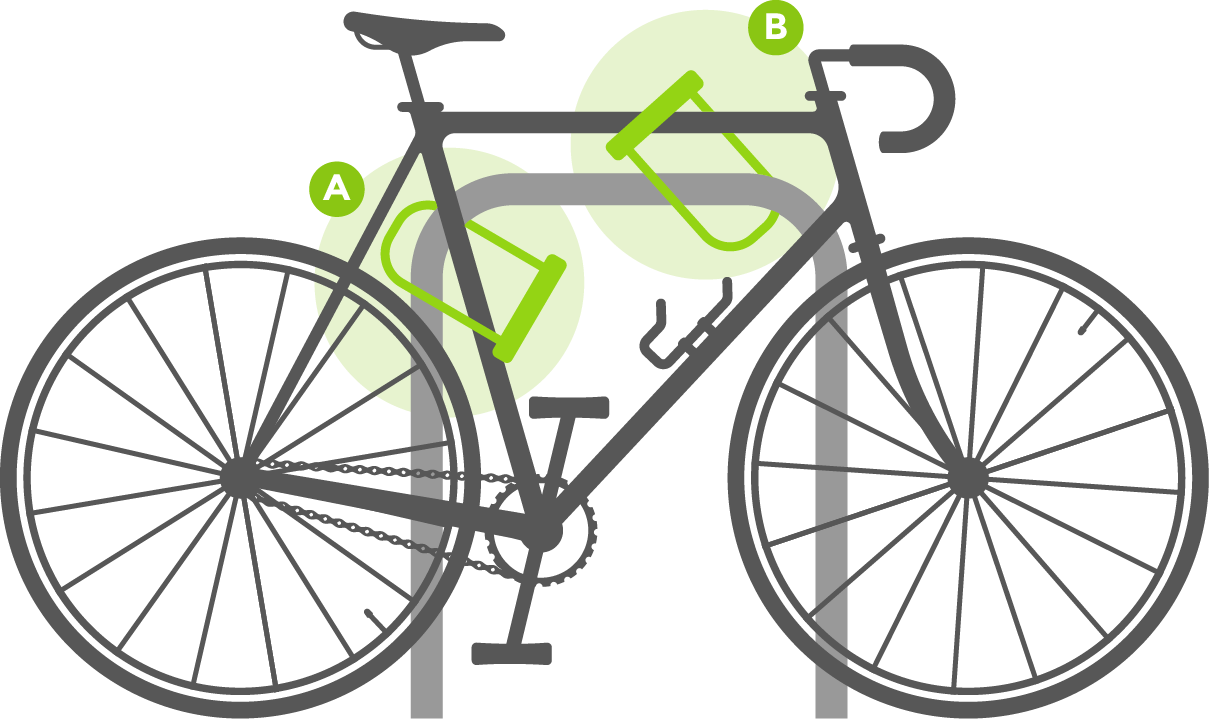Nearly 80,000 bikes are reported stolen in the UK every year; that's more than 200 bikes a day.
Office for National Statistics
Why is bike security so important?
If you have bike insurance through Cycleplan, it’s important that you follow the guidelines in your policy wording to ensure you’ve locked your bike correctly using the required level of approved lock. You need to think about:
- Do you have the appropriate Sold Secure or Thatcham lock?
- Are you securing your bike properly when out and about?
- Are you storing it correctly when at home?
- Are you leaving your bike unattended longer than you should when out and about?
Below, we’ll look at how to secure your bike in different scenarios, how to buy the right bike lock, and how to use your lock properly.
Where to store your bike at home
In your house or flat:
If you store your bike in your private house or flat, there is no need to lock it up as long as your windows and door are locked. The same applies if you decide to keep it within your room in a shared house.
In a secure outbuilding:
*Garage, shed, purpose-built immovable bike storage box, or other outbuilding built from brick, stone, wood or metal.
The windows and doors of the garage or shed must be locked, and the doors must be secured with either the manufacturer's installed lock, a 5-lever mortice deadlock, or a 5-pin padlock.
In a shared area in a house or flat:
This can include shared hallways, balconies, communal bike lockers, or underground car parks that only residents can access. If you keep your bike in any shared area with other residents, it must be secured to an immovable object with an approved lock.
How to store your bike away from home
Whether you're travelling to work or taking your bike on holiday, there are certain guidelines you must follow to ensure you're still covered by your bike insurance. These include:
Secure your bike in place
Always lock your bike to an immovable object using an approved lock, which secures the bike and any quick-release wheels.
Don't leave your bike unattended
Never leave your bike for more than 12 hours, or no more than 24 hours if you're storing your bike at work or a train or bus station.
Taking your bike on holiday
If you're taking your bike on holiday with you, the same rules apply as when storing your bike at home (outlined above).
If you already have a lock and it doesn’t state the Sold Secure rating on the packaging, you can search for all current Sold Secure approved locks on the Sold Secure website.
Storing your bike in a vehicle
If you choose to store your bike in or on a vehicle, you must make sure that:
- All doors, windows, and the convertible roof of the vehicle (if you have one) are shut and locked.
- If the bike is secured to a roof rack, it must be held in place with an approved lock.
Buying a bike lock
The bike lock rating system
Most bike locks are rated on a 'Sold Secure' scale to either Bronze, Silver, Gold, or Diamond standard. How your bike lock is rated is important for your insurance, as you must ensure that your bike lock has the minimum rating required for your bike’s value.
The best type of bike lock
D locks and chain locks are generally considered some of the strongest for securing your bike. Both are robust and will pose a challenge to any potential bike thief.
Whatever type of bike lock you buy; keep the proof of purchase as this will be required should you need to make a theft claim in future.
How to lock a bike
Make sure you always choose a fixed, immovable object to lock your bike to when using an approved lock. The object should be fitted to concrete, stone, brick, metal, or a motor vehicle with no way to remove the bike from it.
It's best to identify a location that is well lit with a high footfall if you can, or somewhere that you know CCTV is in operation. Don't forget to take all the removable accessories with you when leaving your bike, too.
Fixed wheels
If your bike has fixed wheels (i.e. not quick release), attach the approved lock around the frame and the immovable object (examples: point A or B).

Quick release wheels
If one or both of your wheels are quick release, attach the approved lock around the rear wheel, removed front wheel, the frame and the immovable object (point C).

Refer your friends and you’ll both be rewarded
If you choose to refer your friends to us, not only will we reward you with a voucher of your choice but your friends will receive an exclusive discount too!
Bike security tips & advice

